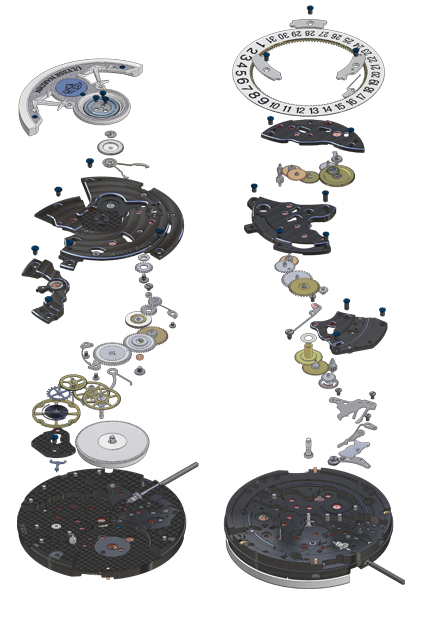True watch enthusiasts know there is more to a timepiece than meets the eye. They look for precise unity between the intricate works. Here is a guide to the horological terms and elements that distinguish a luxury watch from all the others.
Consisting of a watch’s middle, bezel, and back, it protects and houses the movement inside. It can be made from different metals and in different shapes. The examples below illustrate common case shapes currently being produced.
CRYSTAL
The Crystal is a ‘glass’ covering the dial or ‘face’ of the watch, protecting it from dirt and water. There are three major types of crystals produced and used in watch making.
DIAL
The dial is the face of the watch. There are many ways a dial can be marked. The examples below show some of the most popular dials.
SUBDIAL
A small dial set within the main dial, used to display an additional complication such as Chronograph readout, seconds, or date.
HOUR MARKER
An hour indicator applied or painted on the dial of the watch.
HANDS
The hands on a watch indicate either the hour, minute, or second, along with other functions. Often taking their cues from the general aesthetic of the watch, the hands can vary in shape, size and style.
CROWN
Connects to the internal movement of a watch through the case, the crown, which can vary from a simple gasket to an intricate system of screws, allows you to wind, hand-set, and employ special functions like date settings and time.
SCREW-DOWN CROWN
A crown which aids water resistance by sealing it against the case. The seal is achieved through gaskets and by matching the threaded pipe on the case with the crown’s internal threads, while twisting the crown to lock it into place.
PUSHER/span>
Otherwise dubbed a ‘push-piece’ or a ‘push-button’, this handy mechanical element is mounted on a watch’s case to control specific functions, such as timing functions in a chronograph.
BEZEL
The bezel is either snapped or screwed into the case and often holds the crystal, the protective covering of the watch, in place. Bezels can be functional for diving and timing or purely aesthetic, as with a diamond set bezel.
STRAP
Whatever your favorite look-leather, alligator, canvas, or other-the strap is attached to the case and bound by a buckle, keeping your watch on tight.
BRACELET/span>
Usually made of metal or in combination with another material such as rubber, as with link watch bands, the bracelet keeps your timepiece securely attached and looking sharp. When there is no discontinuity between the bracelet and the case, this is called an ‘integral’ bracelet.
ARDILLON BUCKLE (TANG BUCKLE):
A traditional buckle in which one end of the strap is slipped through a buckle with a pin used to secure the fit of your watch.
DEPLOYANT BUCKLE
A deployant, or fold-over clasp, is an elegant flourish that allows for perfect strap closures through interlocking metal pieces, eliminating the need for strap holes. It is considered safer to wear than a regular Ardillon buckle. If the buckle should happen to open up, the watch is still attached to the wrist.
MOVEMENTS:
The movement is the engine of the watch; it makes the watch work. The different types of movements and the importance of their functionality are explained in greater detail in the Movements section.
ROTOR
In automatically winding timepieces, the rotor’s partial or complete revolutions work in conjunction with the movements of the human arm. The rotor turns freely in both directions to wind the mainspring, which stores and transmits the energy that powers your watch.
LUG/span>
A case attachment, the lug allows for a strap or bracelet to be attached to the watch case. Ensures that your ticker isn’t going anywhere you don’t want it to.
EXHIBITION CASE BLACK:
A case back to show off movement finishing and craftsmanship. Ideal for anyone who appreciates the intricate inner-workings of a timepiece, an exhibition back displays the mechanical workings of a watch.
SKELETON MOVEMENT
This watch does not contain a dial. It exposes the movement, etched and engraved to a high degree of craftsmanship, from the face of the watch.
CHRONOMETER:
A watch with a particularly high level of precision. According to Swiss law, a watch may not be dubbed a chronometer until it has passed a series of grueling tests and measurements, just like the Navy SEALs.

